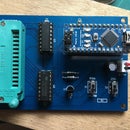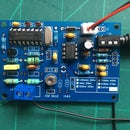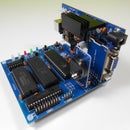Introduction: Adding a Longer Aerial to the AM Transmitter / Modulator(s)
This is an add on design for my AM modulator circuits. It gives an outline of how to use a 2/3 metre aerial with either design. This in turn leads to a greater transmission distance.
Note: AM occasionally suffers from interference, sometimes a low drone sound, sometimes chatter or a whistle in the background. This can effect any or all of the stations on MW including this transmitter. It's normally caused by weather conditions or things like sun-spots etc. It usually clears after a few hours, sometimes moving your radio a little can help etc. It's not a fault.
Please be aware, the CD4060 and the 100uf capacitor can be damaged by reverse polarity, once shorted they remain short circuit - even when the power is re-connected correctly! With modern batteries this will short the battery and may cause it to overheat. I suggest you connect the battery ONE terminal at a time to reduce the risk of accidentally reversing the power by mistake.
In later versions of the board/circuit I have added a diode to prevent the above issue.
Supplies
You will need:
2x in34 (any germanium diode will work)
1x 10nf capacitor
1x 3mm LED red, since red has the lowest voltage it is the best colour to use here.
20-30cm of hookup wire.
20-30cm of wire with a clip on one end to use as ground connection (or pcb -ve)
120pf capacitor mini trimmer, if you use a smaller value you may need to add extra fixed capacitance to compensate. With the new inductor fitted the capacitor needs to be around 50-80pf depending on your board frequency.
Replacement L2 (currently 330uh). Depending on the trimmer you may need to use either a slightly bigger/smaller inductor or add a capacitor in parallel with the trimmer. Typical values that I have tested are:
1mhz - 470uh
750khz - 680uh
625khz - 1mh
These boards are available ready made on ebay. Or if you want advice on suppliers for above parts contact me.
Step 1: The Original Design
Originally this board(s) was designed to operate at close distance to the radio and with only a 1 metre aerial. The two projects can be found:
https://www.instructables.com/AM-Radio-Modulator-Short-Range-Transmitter-V2/
https://www.instructables.com/AM-Radio-Modulator-Short-Range-Transmitter/
The board being modified here is the first of the two above, operating at 921khz. The same changes will work on both boards at any of the frequencies used.
Step 2: Building the Signal Strength Indicator
It's useful to have a simple way of knowing the peak output of the board. This simple LED circuit uses two germanium diodes as a voltage doubler and a capacitor to rectify this to DC, finally an LED to show the relative output.
Non of the components are critical, you can use silicon diodes at a push, but germanium gives better results. The LED, a RED is better - it has a lower operating voltage.
As you can see from the above picture construction is a simple case of joining the diodes cathode to anode, then solder the capacitor and LED in place. No PCB or prototype board is needed, of course you can use one if you want.
The small aerial (20-30cm of wire connected to the junction of the diodes) just hangs free.
To test it hold the cathode side of the LED, turn on the modulator and bring the wire aerial near the modulators aerial. It should light dimly.
When you adjust the output, later in this article, keep the distance between the aerials the same - so as not to effect the brightness of the LED except with adjustment.
Step 3: Changes to Make
Replace the original output capacitor, C14/C15, with the 120pf trimmer and any additional capacitors needed if you choose a smaller trimmer, see table below, it's a guide only as many environmental conditions can effect the final value. The pins on the trimmer are going to be too wide for the PCB holes. You can either solder wires to the pins or as I did cut the pins down the centre long ways down the leg with a pair of side cutters.
Freq C14/15 Range
625khz 65-85pf using trimmer
725khz 50-70pf using trimmer
921khz 40-60pf using trimmer
1mhz 30-50pf using trimmer
Replacement L2/L3 (currently 330uh). Depending on the trimmer you may need to use either a slightly bigger/smaller inductor or add a capacitor in parallel with the trimmer. Typical values that I have tested are:
1mhz - 470uh, 750khz - 680uh, 625khz - 1mh
Replace the areal with a 3m length of wire.
Optional changes:
It is possible to increase output drive a little by reducing the 270ohm (R3) resistor to 100ohm. It does not make a massive difference.
IMPORTANT, BATTERY USAGE. With the longer aerial and better matching to it the boards will use more current and this will reduce battery life. For example my board went from 13-14ma to around 23-25ma, almost double. If you use a 12v battery this will increase further. This does mean that you will be exceeding 100mw output and you must make sure you are allowed to do this in your country. Do not break the law.
If you are concerned over this, do not do the optional resistor change mentioned above. In fact you may want to increase the value of R3 so as to reduce the current used and limit the power.
I suggest using a 12volt battery instead of the 9v one. This is best accomplished with a 8 x 1.5v either AAA or AA battery holder, the kind that has a 9v battery clip on it is ideal (but not easy to find) or solder the fly leads from a normal holder into the holes labeled J2 (small semi circle connects to +v). CHECK the polarity is correct before use.
You may want to add a small switch at the same time.
Step 4: Adjust the Output for Best Match
I'm not going to cover the theory here on aerial matching, you can find extensive details on the web. The output on this board uses a simple Pi network,
Position the 3 metre wire used for the aerial, you can for example "pin" or "tack" it to a wall. Keep it as high as possible. Avoid metal objects and existing house wiring as best you can.
Optional (but recommended) connect a ground wire (from a radiator or other copper pipe work etc) to the PIN labeled G on the aerial connector.
Remove the audio lead. Connect the cathode to the ground pin on the audio pins (use a crocodile jumper lead etc). Keep the 20 cm aerial a few centimetres from the main aerial and adjust the trimmer for the best LED output.
You can now test away!
Step 5: Taking It to the MAX (optional)
These changes are optional and may be against the law in your country. Do not break the law.
There are several other changes you can make to the basic circuit, when you add them all up you can generate more than 200mw of RF at the aerial. This is more than enough to reach through the house and garden.
In the picture above you can see a later version of the board, if constructed as per the original circuit it works the same. But has an on-board LED indicator (it's the same circuit as mentioned above, just built on the PCB).
However if you replace R3 with a smaller value, 47r for example and run the board at 12v the whole circuit (at best match to aerial) consumes some 60-70ma. The CD4046 and LM386 use around 10ma so the output stage must be using 50ma minimum. Ohms law states P=V x I, so 12vX50ma = 600mw. In reality this would be peak and other losses occur as well. But with no signal input. the LM386 outputs approx 6v, the board takes around 35ma. So a more realistic estimate 6v x 35ma = 210mw.
At this current the LM386 is at MAX and does run warm! You may want a small glue on heat sink, although it does not seem to cause it any real problems. If your building from new, i suggest you use the LM386-4 (4=gives more power output and has a higher voltage supply rating).
Make sure to use 1W or at least 1/2W 1mh/680uh inductor, avoid the 1/4W ones if possible - they have to much DC resistance.
To get this working:
47R replaces the 270R resistor R3
Run at 12v, you WILL need 8x AA or 8x AAA or a PSU of at least 200ma
Use a 3 metre aerial, as high as possible preferable vertical or at least a steep angle.
Optional but recommended, use an earth connection.
Have fun, remember to check you are allowed to use this power in your country!
Step 6: Modulation Hum
Low power AM transmitters can suffer from something called “modulation hum”. This term can sometimes be confusing - it sounds like it's created by the transmitter, however this is not really the case. Mainly the “hum” is caused by re-radiation of the transmitter signal, for example mains cables pick up the signal and it resonates to the point where it radiates the signal again, but annoyingly with the main 50/60hz “hum” now causing additional modulation.
Possible sources of hum and things to try to help fix it.
EVERYTHING that follows assumes you have connected the transmitter to GROUND!
1, If you have to low an audio signal in, then the carrier will not be modulated at the best level and this can increase the likelihood of secondary modulation. Increase the audio source signal level (volume).
2, Hum can be introduced on the audio cables by a ground loop. A ground loop will occur when the audio source device is connected to a ground that is different from the transmitter ground. You can check for a ground loop by unplugging your audio source from the transmitter. If the hum drops a lot or goes away, you may have a ground loop. Good grounding will help prevent this.
3, AC building induced hum. By far the most common source of hum with indoor transmitters. You can check for this type of hum by disconnecting the audio cables from the transmitter. If the hum persists or increases, you have AC wiring induced hum. AC wiring can induce hum on the part of the signal that it re-radiates. Often you will note that a radio placed close to the transmitter will not have any hum, but a radio in a distant room will have hum.
Connecting the transmitter ground to a grounded metal point such as copper water pipe etc is often the best solution. It can bypass much of the signal that normally couples into the wiring. Try to eliminate the source of the AC wiring hum. Any device that has a switching-type power supply can cause hum. For example low energy lights, lamp dimmers, mobile phone chargers, Wi-Fi router, PC’s etc. Also, turn off all lamp dimmers completely.
If your radio has an internal directional antenna, try rotating the radio. Often you can find a position where the signal is still strong, but the hum is markedly reduced.
4, As well as ensuring a good ground is in use, you can often reduce eliminate hum by re-positioning the aerial - you may ned to try several place to get the best results. Try to avoid putting the aerial near wiring of any kind (keep in mind where mains wiring is likely to be inside walls and floors etc). Keep the aerial away from large metal objects (kitchen appliances, wall radiators etc). Also keep it clear to TV’s and electric fires/radiators etc.
Step 7: Keep in Mind
It's worth trying different positions and lengths of the aerial, sometime a 2 metre length can work better. Adjust the trimmer using your signal strength diode each time.
DO NOT exceed 12v, the lm386 will not like it!
KEEP IN MIND. You need to stay legal, look up the rules for your country. Always check first!













